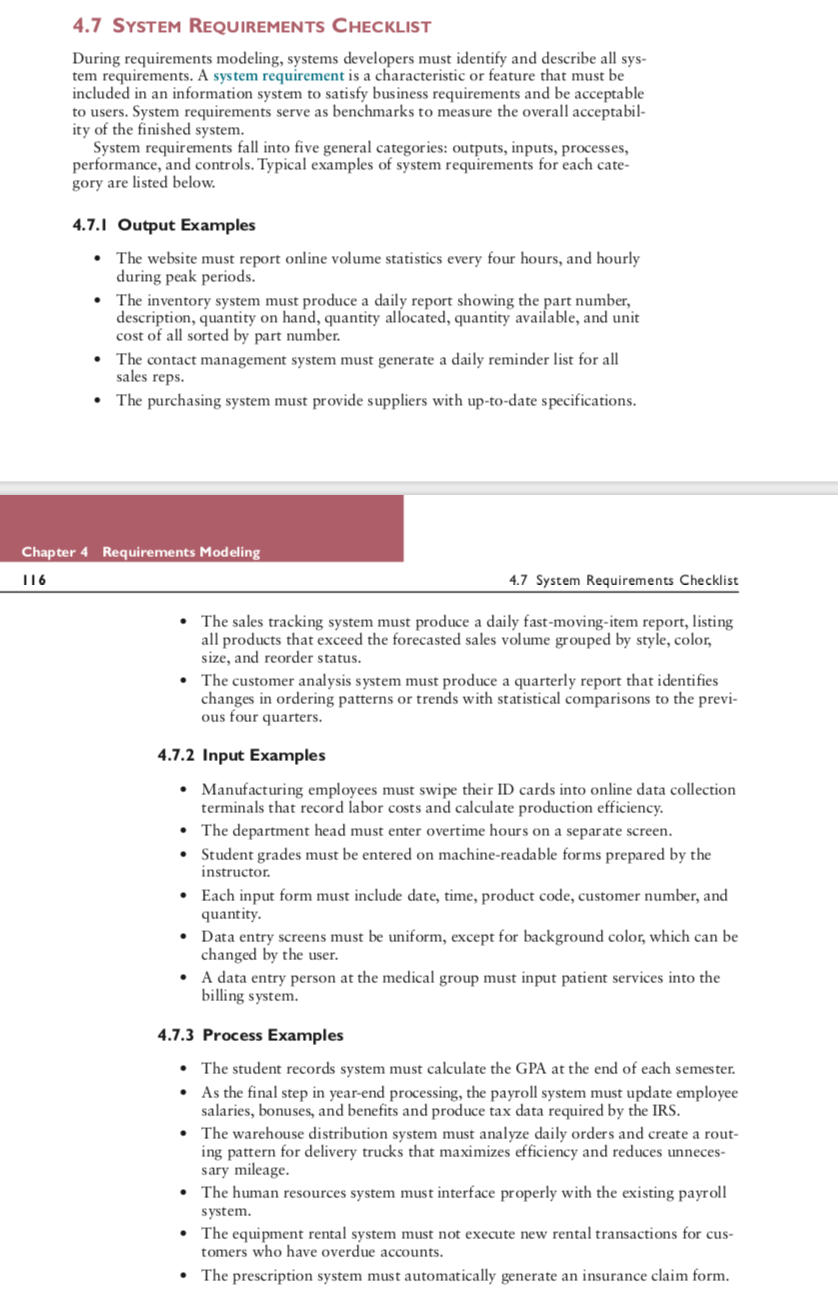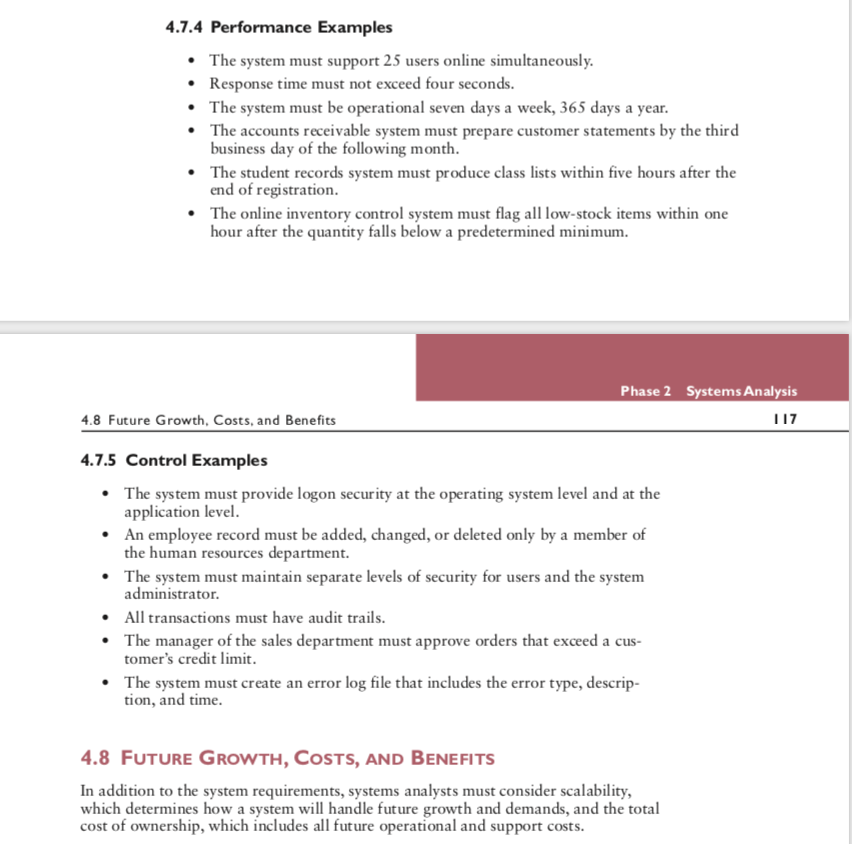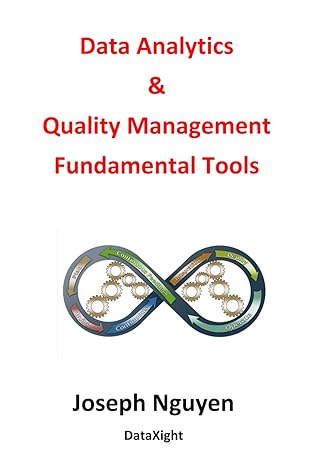Requirements Definition
Consider the following scenario: You work for a small retailer. The company has three locations in the Portland area. They sell retro & collectible video game consoles and cartridges. You and your partner have been hired to manage the computers, networks, point-of-purchase systems, the website, and various other technologies for this company. Recently, sales have been dropping. The marketing manager conducted a customer survey and determined that their customers have been making more purchases online because it is more convenient (and sometimes cheaper). Your company doesnt currently sell any products online. You and your partner have been tasked with the project of selling stuff online. Assume you are going to build an e-commerce website to sell products online. Now answer the following questions:
- Review the System Requirements Checklist in the textbook. Develop a list of four input requirements.
- Review the System Requirements Checklist in the textbook. Develop a list of four output requirements.
- Review the System Requirements Checklist in the textbook. Develop a list of four process requirements.
- Review the System Requirements Checklist in the textbook. Develop a list of four performance requirements.
- Review the System Requirements Checklist in the textbook. Develop a list of four control requirements.
please review the example in the textbook need to be


4.7 SYSTEM REQUIREMENTS CHECKLIST During requirements modeling, systems developers must identify and describe all sys- tem requirements. A system requirement is a characteristic or feature that must be included in an information system to satisfy business requirements and be acceptable to users. System requirements serve as benchmarks to measure the overall acceptabil- ity of the finished system. System requirements fall into five general categories: outputs, inputs, processes, performance, and controls. Typical examples of system requirements for each cate- gory are listed below. 4.7.1 Output Examples The website must report online volume statistics every four hours, and hourly during peak periods. The inventory system must produce a daily report showing the part number, description, quantity on hand, quantity allocated, quantity available, and unit cost of all sorted by part number. The contact management system must generate a daily reminder list for all sales reps. The purchasing system must provide suppliers with up-to-date specifications. Chapter 4 Requirements Modeling 116 4.7 System Requirements Checklist The sales tracking system must produce a daily fast-moving-item report, listing all products that exceed the forecasted sales volume grouped by style, color, size, and reorder status. The customer analysis system must produce a quarterly report that identifies changes in ordering patterns or trends with statistical comparisons to the previ- ous four quarters. 4.7.2 Input Examples Manufacturing employees must swipe their ID cards into online data collection terminals that record labor costs and calculate production efficiency. The department head must enter overtime hours on a separate screen. Student grades must be entered on machine-readable forms prepared by the instructor. Each input form must include date, time, product code, customer number, and quantity. Data entry screens must be uniform, except for background color, which can be changed by the user. A data entry person at the medical group must input patient services into the billing system. 4.7.3 Process Examples The student records system must calculate the GPA at the end of each semester. As the final step in year-end processing, the payroll system must update employee salaries, bonuses, and benefits and produce tax data required by the IRS. The warehouse distribution system must analyze daily orders and create a rout- ing pattern for delivery trucks that maximizes efficiency and reduces unneces- sary mileage. The human resources system must interface properly with the existing payroll system. The equipment rental system must not execute new rental transactions for cus- tomers who have overdue accounts. The prescription system must automatically generate an insurance claim form. 4.7.4 Performance Examples The system must support 25 users online simultaneously. Response time must not exceed four seconds. The system must be operational seven days a week, 365 days a year. The accounts receivable system must prepare customer statements by the third business day of the following month. The student records system must produce class lists within five hours after the end of registration. The online inventory control system must flag all low-stock items within one hour after the quantity falls below a predetermined minimum. Phase 2 Systems Analysis 4.8 Future Growth, Costs, and Benefits 117 4.7.5 Control Examples The system must provide logon security at the operating system level and at the application level. An employee record must be added, changed, or deleted only by a member of the human resources department. The system must maintain separate levels of security for users and the system administrator. All transactions must have audit trails. The manager of the sales department must approve orders that exceed a cus- tomer's credit limit. The system must create an error log file that includes the error type, descrip- tion, and time. 4.8 FUTURE GROWTH, COSTS, AND BENEFITS In addition to the system requirements, systems analysts must consider scalability, which determines how a system will handle future growth and demands, and the total cost of ownership, which includes all future operational and support costs. 4.7 SYSTEM REQUIREMENTS CHECKLIST During requirements modeling, systems developers must identify and describe all sys- tem requirements. A system requirement is a characteristic or feature that must be included in an information system to satisfy business requirements and be acceptable to users. System requirements serve as benchmarks to measure the overall acceptabil- ity of the finished system. System requirements fall into five general categories: outputs, inputs, processes, performance, and controls. Typical examples of system requirements for each cate- gory are listed below. 4.7.1 Output Examples The website must report online volume statistics every four hours, and hourly during peak periods. The inventory system must produce a daily report showing the part number, description, quantity on hand, quantity allocated, quantity available, and unit cost of all sorted by part number. The contact management system must generate a daily reminder list for all sales reps. The purchasing system must provide suppliers with up-to-date specifications. Chapter 4 Requirements Modeling 116 4.7 System Requirements Checklist The sales tracking system must produce a daily fast-moving-item report, listing all products that exceed the forecasted sales volume grouped by style, color, size, and reorder status. The customer analysis system must produce a quarterly report that identifies changes in ordering patterns or trends with statistical comparisons to the previ- ous four quarters. 4.7.2 Input Examples Manufacturing employees must swipe their ID cards into online data collection terminals that record labor costs and calculate production efficiency. The department head must enter overtime hours on a separate screen. Student grades must be entered on machine-readable forms prepared by the instructor. Each input form must include date, time, product code, customer number, and quantity. Data entry screens must be uniform, except for background color, which can be changed by the user. A data entry person at the medical group must input patient services into the billing system. 4.7.3 Process Examples The student records system must calculate the GPA at the end of each semester. As the final step in year-end processing, the payroll system must update employee salaries, bonuses, and benefits and produce tax data required by the IRS. The warehouse distribution system must analyze daily orders and create a rout- ing pattern for delivery trucks that maximizes efficiency and reduces unneces- sary mileage. The human resources system must interface properly with the existing payroll system. The equipment rental system must not execute new rental transactions for cus- tomers who have overdue accounts. The prescription system must automatically generate an insurance claim form. 4.7.4 Performance Examples The system must support 25 users online simultaneously. Response time must not exceed four seconds. The system must be operational seven days a week, 365 days a year. The accounts receivable system must prepare customer statements by the third business day of the following month. The student records system must produce class lists within five hours after the end of registration. The online inventory control system must flag all low-stock items within one hour after the quantity falls below a predetermined minimum. Phase 2 Systems Analysis 4.8 Future Growth, Costs, and Benefits 117 4.7.5 Control Examples The system must provide logon security at the operating system level and at the application level. An employee record must be added, changed, or deleted only by a member of the human resources department. The system must maintain separate levels of security for users and the system administrator. All transactions must have audit trails. The manager of the sales department must approve orders that exceed a cus- tomer's credit limit. The system must create an error log file that includes the error type, descrip- tion, and time. 4.8 FUTURE GROWTH, COSTS, AND BENEFITS In addition to the system requirements, systems analysts must consider scalability, which determines how a system will handle future growth and demands, and the total cost of ownership, which includes all future operational and support costs








